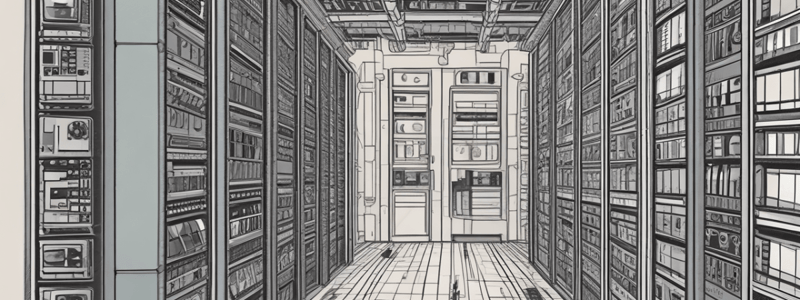Podcast
Questions and Answers
How is non-volatile memory viewed in the context of computer systems?
How is non-volatile memory viewed in the context of computer systems?
- As part of the I/O system (correct)
- As a separate entity from the memory hierarchy
- As part of the main memory bus
- As a volatile memory component
What is a benefit of RAID 5 configuration?
What is a benefit of RAID 5 configuration?
- It allows for faster data transfer rates
- It provides a higher storage capacity
- It offers better data redundancy (correct)
- It is more cost-effective than other RAID configurations
What is the purpose of error-correcting codes in storage systems?
What is the purpose of error-correcting codes in storage systems?
- To prioritize data for faster access
- To compress data for faster storage
- To encrypt data for secure storage
- To detect and correct data errors during transmission (correct)
How does parity work in data restoration?
How does parity work in data restoration?
What is a characteristic of high-performance storage architectures?
What is a characteristic of high-performance storage architectures?
What is a key feature of RAID 1 configuration?
What is a key feature of RAID 1 configuration?
What is the primary performance bottleneck in the storage node?
What is the primary performance bottleneck in the storage node?
What is the approximately cost per IOPS of the storage system?
What is the approximately cost per IOPS of the storage system?
What is the formula to calculate availability?
What is the formula to calculate availability?
What is the estimated mean time to fail of the rack?
What is the estimated mean time to fail of the rack?
What is the main advantage of using RAID 5 over RAID 1?
What is the main advantage of using RAID 5 over RAID 1?
What is the purpose of error-correcting codes in storage systems?
What is the purpose of error-correcting codes in storage systems?
What is the primary benefit of using parity in storage systems?
What is the primary benefit of using parity in storage systems?
What is the main characteristic of high-performance storage architectures?
What is the main characteristic of high-performance storage architectures?
What is the estimated cost per terabyte of the storage system?
What is the estimated cost per terabyte of the storage system?
What is the main factor contributing to the high cost of the storage system?
What is the main factor contributing to the high cost of the storage system?
What is the main purpose of seek time in magnetic disks?
What is the main purpose of seek time in magnetic disks?
What is the average rotational latency (ARL) in magnetic disks?
What is the average rotational latency (ARL) in magnetic disks?
What is the primary benefit of RAID systems?
What is the primary benefit of RAID systems?
What is the main characteristic of RAID 0?
What is the main characteristic of RAID 0?
What is the primary difference between reliability and availability?
What is the primary difference between reliability and availability?
What is the formula to calculate the average seek time (AST)?
What is the formula to calculate the average seek time (AST)?
What is the primary benefit of increasing the recording density in magnetic disks?
What is the primary benefit of increasing the recording density in magnetic disks?
What is the formula to calculate the disk access time (DAT)?
What is the formula to calculate the disk access time (DAT)?
What is the primary advantage of using error-correcting codes in magnetic disks?
What is the primary advantage of using error-correcting codes in magnetic disks?
What is the main purpose of parity in RAID systems?
What is the main purpose of parity in RAID systems?
Flashcards are hidden until you start studying
Study Notes
Storage
- Non-volatile memory can be viewed as part of the memory hierarchy system or I/O system
- Characteristics of storage include: seek time, rotational latency, and transfer time
- Seek time: 5-12 ms, with actual time being 25-33% of reported time due to locality of disk references
- Rotational latency: average 8 ms to 2 ms, depending on RPM (3,600 to 15,000) and disk diameter (1.0 to 3.5 inches)
- Transfer time depends on transfer size per sector, rotation speed, and recording density
- Magnetic disks evolution has led to increased density, reduced prices, and increased RPM
Magnetic Disks Performance
- Average seek time (AST) is the sum of time for all possible seeks divided by the total number of possible seeks
- Rotational latency (ARL) is half the rotation period, with common values being 5,400 and 7,200 RPM
- Transfer time depends on transfer size, rotation speed, and recording density
- Disk access time (DAT) is the sum of seek time, rotational latency, transfer time, controller time, and queuing delay
RAID Systems
- RAID (Redundant Array of Independent Disks) systems are designed for reliability and availability
- Characteristics: multiple simultaneous accesses, data stripping, and mirroring to increase availability
- Reliability vs availability: more disks mean greater fail probability, but failures do not necessarily lead to unavailability
- RAID levels summary: level 0 (not redundant, but efficient), level 1 (mirroring), and level 3 (striping with parity)
I/O Servers - Clusters
- Performance evaluation: the network switch can be the bottleneck if it cannot support the required bandwidth
- Cost: disks represent almost 70% of the total cost, with a cost per terabyte of almost $1,000 and cost per IOPS of about $7
- Dependability: mean time to failure (MTTF), mean time to repair (MTTR), and mean time between failures (MTBF)
- Availability: MTTF / (MTTF + MTTR)
I/O Servers - Clusters (cont.)
- Dependability: resulting mean time to fail of the rack, with assumptions about MTTF for various components (CPU, memory, enclosure, disks, controllers, switches, power supplies, and fans)
- Calculation of failure rate and MTTF for the rack
Studying That Suits You
Use AI to generate personalized quizzes and flashcards to suit your learning preferences.




